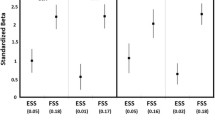Abstract
Purpose
This observational study seeks to describe the distribution of sleepiness among elderly male veterans and to explain the relationship between sleepiness and age, function, mobility, and depression in this population.
Methods
Veterans who were age 60 or older and had two or more functional limitations based on their activities of daily living or instrumental activities of daily living were recruited in outpatient clinics. They were recruited as part of a longitudinal study and completed questionnaires reported here at the 18-month data collection time point.
Results
Veterans report higher sleepiness than normal controls. Self-reported sleepiness scores are similar to those of patients who have been diagnosed with sleep disturbances.
Conclusions
Interventions to identify and support aging veterans with perceived sleepiness should be developed and carefully evaluated.

Similar content being viewed by others
References
Crenshaw M, Edinger C, Edinger JD (1999) Slow-wave sleep and slow-wave sleep and waking cognitive performance among older adults with and without insomnia complaints. Physiol Behav 66:485–92
Briones B, Adams N, Strauss M, Rosenberg C, Whalen C, Carskadon M, Roebuck T, Winters M, Redline S (1966) Relationship between sleepiness and general health status. Sleep 96:583–8
Martin JL, Shochat T, Gehrman PR, Ancoli-Israel S (1999) Sleep in the elderly. Respir care clinics N Am 5:461–72
Ancoli-Israel S (1989) Epidemiology of sleep disorders. Clin Geriatr Med 5:347–62
Jelicic M, Bosma H, Ponds RWHM, Van Boxtel MPJ, Houx PJ, Jolles J (2002) Subjective sleep problems in later life as predictors of cognitive decline. Report from the Maastricht Ageing Study (MAAS). Int J Geriatric Psychiatry 17:73–7
Goldstein IB, Ancoli-Israel S, Shapiro S (2004) Relationship between daytime sleepiness and blood pressure in healthy older adults. Am J Hypertension 17:787–92
Moldofsky H (1992) Evaluation of daytime sleepiness. Clin Chest Med 13:417–25
Foley D, Anacoli-Israel S, Britz P, Walsh J (2004) Sleep disturbances and chronic disease in older adults: results of the 2003 National Sleep Foundation Sleep in America Survey. J Psychosomatic Research 56:497–502
Abbott KH, Stoller EP, Rose JH (2007) The structure and function of frail mail veterans’ informal networks. J Aging Health 19:757–77
Johns MW (1991) A new method for measuring daytime sleepiness: the Epworth sleepiness scale. Sleep 14:540–545
Johns MW (1992) Reliability and factor analysis of the Epworth sleepiness scale. Sleep 15:376–81
Chervin RD, Aldrich MS, Pickett R, Guilleminault C (1997) Comparison of the results of the Epworth sleepiness scale and the multiple sleep latency test. J Psychosom Res 42:145–55
Pfeiffer E (1975) A Short Portable Mental Status Questionnaire for the assessment of organic brain deficit in elderly patients. J Am Geriatric Soc 23:433–41
Charlson ME, Pompei P, Ales KL, McKenzie CR (1987) A new method of classifying prognostic comorbidity in longitudinal studies: development and validation. J Chronic Disease 40:373–83
Katz S, Ford AB, Moskowitz RW, Jackson BA, Jaffe MW (1963) Studies of illness in the aged. The index of ADL: a standardized measure of biological and psychosocial function. JAMA 185:914–19
Fillenbaum GG (1988) Multidimensional functional assessment of older adults. Lawrence Erlbaum Associates, Hillsdale, New Jersey
Kane RL, Kane RA (2000) Assessing older persons: measures, meaning, and practical applications. Oxford University, New York
Sheikh JI, Yesavage JA (1986) Geriatric depression scale (GDS) recent evidence and development of a shorter version. Clin Gerontol 5:165–73
Sharafkhaneh A, Richardson P, Hirshkowitz M (2004) Sleep apnea in a high risk population: a study of Veterans Health Administration beneficiaries. Sleep Med 5:345–50
Onen F, Moreau T, Gooneratne NS, Petit C, Falissard B, Onen SH (2013) Limits of the Epworth sleepiness scale in older adults. Sleep Breath 17:343–50
Acknowledgments
The authors wish to acknowledge the numerous contributions of the following individuals in data collection and implementation: Melissa Cappaert, Tanetta Anderson, Anthony D’Eramo, Denise Kresevic, and Patricia Higgins.
Conflict of interest
The authors have no conflict of interest to declare.
Author information
Authors and Affiliations
Corresponding author
Additional information
Data for this project were collected between June 1, 2001 and June 1 2004.
Rights and permissions
About this article
Cite this article
Papp, K.K., Abbott, K.H., Rose, J.H. et al. Sleepiness in elderly veterans. Sleep Breath 18, 283–287 (2014). https://doi.org/10.1007/s11325-013-0879-3
Received:
Revised:
Accepted:
Published:
Issue Date:
DOI: https://doi.org/10.1007/s11325-013-0879-3




